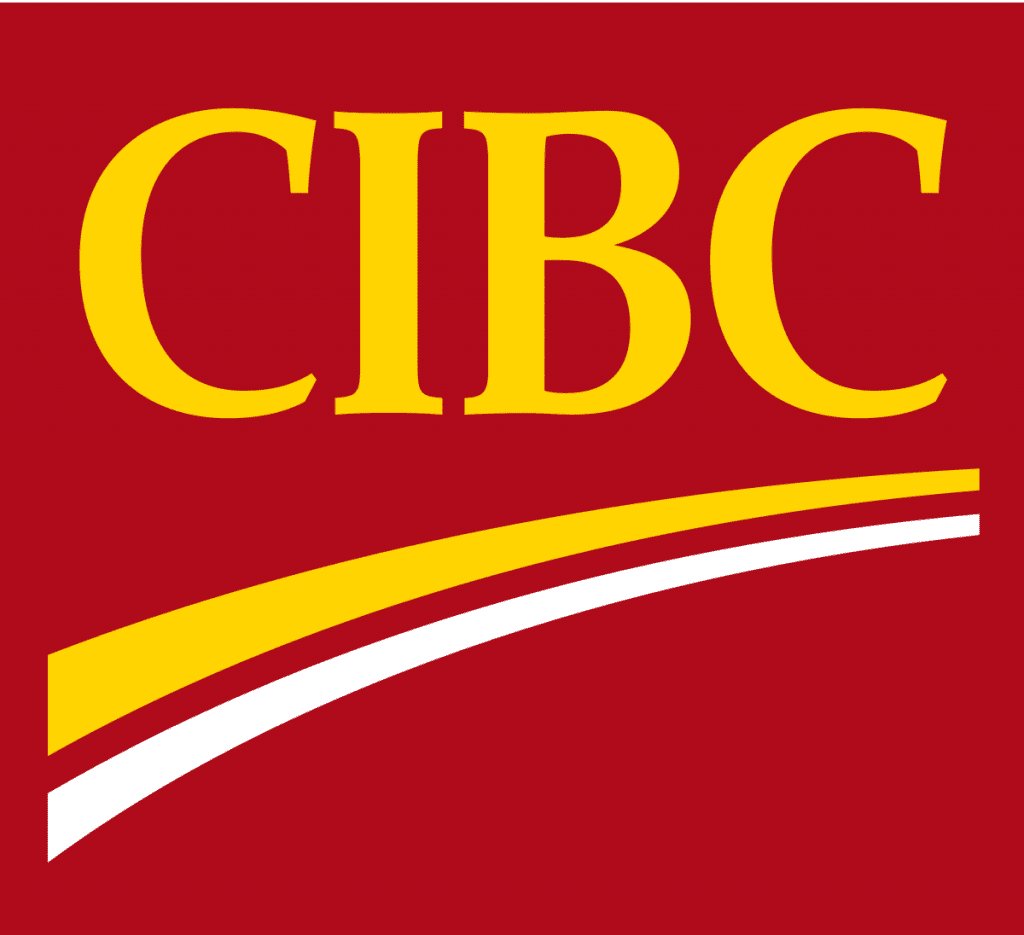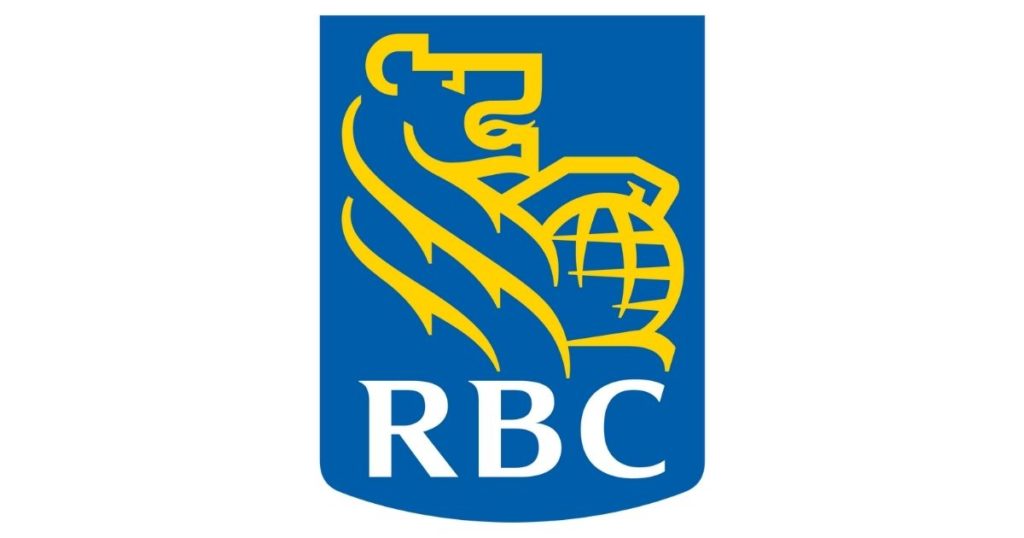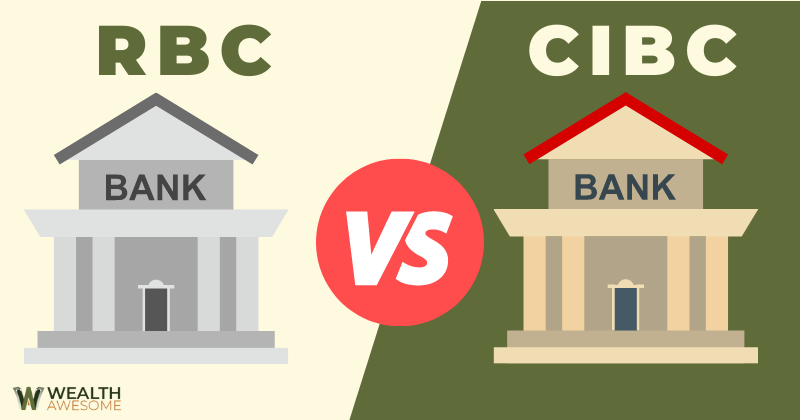Both RBC and CIBC are major players in the Canadian banking industry.
I know that choosing between them can be difficult as their products and services are very comparable.
In this post, I’ll be comparing these two big banks head-to-head in the following five categories to help you decide which one will better suit your banking needs.
- Chequing and Savings Accounts
- Credit Cards
- Loan and Investment Products
- User Experience
- Work Opportunities and Culture (Employment)
We’ll declare a winner in each category and conclude which one is the ultimate winner.
Let’s get started!
A Quick Overview: CIBC

CIBC, short for Canadian Imperial Bank of Commerce, is one of Canada’s “big five” banks. Founded in 1961, the bank is headquartered in Toronto, Ontario and has nearly 50,000 employees across the business.
CIBC is traded on the Toronto Stock Exchange under the stock ticker CM. In 2021, CIBC reported more than $20 billion in revenue.
The bank offers personal, business and commercial banking as well as wealth management and insurance.
A Quick Overview: RBC

The Royal Bank of Canada is Canada’s largest bank by market capitalization. With more than 16 million clients and 86,000 employees, RBC is a giant financial force in Canada and worldwide.
Like CIBC, RBC offers Canadians banking, wealth management and insurance services. Their revenue, however, is significantly higher than CIBC’s (nearly $50 billion in 2021).
RBC has more than $1 trillion in assets under its administration.
Head to Head Comparison: RBC vs. CIBC
Today’s post is going to compare these two financial giants when it comes to their account offerings, credit cards, investment/loan products, user experience and employment.
Stay tuned to the end of the article, where we’ll declare the ultimate winner based on all categories considered.
1. Chequing and Savings Accounts: RBC vs CIBC

RBC: Chequing and Savings Accounts
RBC offers four chequing account options with various features and fees, ranging from $4 per month to $30 “premium” banking.
All fees have the possibility to be lowered or completely waived each month through their “Value Program Rebate” program.
All RBC chequing accounts include free and unlimited Interac e-Transfers, which is fantastic.
The features and rebates included in each package increase with each account, which understandably has a higher monthly price tag.
Depending on your banking habits, an RBC chequing account will definitely meet your needs, albeit at a monthly cost.
When it comes to savings accounts, RBC offers four free options, including a US dollar account. Each account pays interest on its balance, though quite lower than what is available at digital banks.
Product feature:
RBC’s NOMI Find & Save Savings account is quite innovative, which includes software that puts money aside for you based on your transaction and saving habits.
CIBC: Chequing and Savings Accounts
CIBC offers three chequing options: an everyday account with basic features at $4 per month (this account charges $1.50 for Interac e-Transfers), a “Smart” account with free, unlimited transactions and e-Transfers at $16.95 each month, and a “Premium” account at $29.95 per month.
Monthly fees of the Smart and Premium accounts can be waived with minimum balances of $4,000 or $6,000.
Four savings accounts are available at CIBC as well, including a USD savings account and RRSP and TFSA savings.
Winner: Chequing and Savings Accounts
With more options, innovative features, and free e-Transfers all around, RBC is the winner of the chequing and savings account category.
CIBC also has great account options that are honestly not that far off from RBC’s offerings.
However, they are missing a “middle ground” in their chequing accounts, in my opinion, where their $4 account may offer too little for the average consumer, and their $17 account may offer too much at a high cost.
Both banks offer similar savings accounts at comparable interest rates, so they tie when it comes to savings accounts.
2. Credit Cards: RBC vs. CIBC

RBC: Credit Cards
Whether it’s rewards, cash-back, travel, USD, or low-interest, RBC has a large repertoire of credit cards, including some in partnership with companies such as WestJet and British Airways.
The annual fees for these cards range from $0 to nearly $400, and the interest rate is 20% for most of these cards.
You do not have to hold an RBC bank account in order to apply for a RBC credit card.
CIBC: Credit Cards
CIBC also has more than 20 credit cards available for its customers. Ranging from rewards and cash-back to travel, you will definitely be able to find something that fits your needs.
CIBC has a partnership with Costco for some of their credit cards, where you can reap special cash-back advantages at certain restaurants as well as Costco gas. Just note that you must first be a Costco member to apply for this card.
If you are a regular Costco shopper already, I would recommend this card to you to maximize your savings.
Winner: Credit Cards
Both companies tie when it comes to credit cards.
With such a wide range of options and specific partnerships with large third-party companies, you can find something that can easily fit your needs if you do your research well.
I would highly recommend taking advantage of special sign-up perks put in place by both of these banks during certain times of the year.
And don’t forget, you don’t necessarily have to be banking at a specific bank in order to apply for one of their credit cards. You just have to be able to prove that you will be responsible for the amount you borrow each month.
3. Loan and Investment Products: RBC vs. CIBC

RBC: Loan and Investment Products
Apart from bank accounts and credit cards, both RBC and CIBC offer various loan and investment products.
RBC’s loan products are divided into three categories: personal loans, car/vehicle loans and mortgages.
Their personal loans include lines of credit, student loans, home improvement loans and RRSP loans. Their vehicle loans, on the other hand, can be applied to cars, boats, RVs and electric vehicles.
RBC’s mortgages offer competitive rates. In addition, their pre-approval process can be started online, which is convenient.
RBC is quite well-known for its role in the investment space, specifically in Canada. Their investment products and services are widely popular, including platforms such as RBC InvestEase and RBC Direct Investing.
At RBC, you also have access to wealth management and financial advising services.
All in all, I would say that their loan products are standard, but investment products are above average.
CIBC: Loan and Investment Products
CIBC also offers loan and mortgage products as well as investments.
Their loan and mortgage products are heavily comparable to RBC, including the interest rates.
When it comes to investments, you can get just as good advice and wealth management services at either bank, specifically when dealing with mutual funds, GICs, and specific portfolio solutions.
CIBC, however, does not offer as good services when it comes to self-directed investing. Their CIBC Investor’s Edge is good, but it is not as inclusive or widely used as RBC’s self-directed investment products.
Winner: Loan and Investment Products
RBC and CIBC are quite comparable when it comes to their loan, mortgage and wealth management services. RBC, however, comes out on top when it comes to self-directed investing, so it comes out as the winner of this section.
4. User Experience: RBC vs. CIBC

User experience concerns things such as ATM and branch access, mobile and online banking, customer service and other things that may affect your general experience as an account or product holder.
RBC: User Experience
RBC has more than 1,200 branches and 4,000 branches all over Canada, so it’s likely that there will be a branch near your place of residence or occupation to fulfill your banking needs with convenience.
RBC’s mobile banking is also above average, mainly because this technological capacity tends to correlate with the amount of financial resources a bank has. This is, of course, not an issue at RBC.
I’ll also add that RBC’s youth mobile banking application and digital investment services are where users can find a lot of value.
CIBC: User Experience
CIBC has more than 1,000 branches across the nation, in addition to the thousands of ATMs to be used at no additional cost.
CIBC is also known for its great customer service and award-winning mobile application, which has been recognized by organizations such as Forrester Research, JD Power and the Global Finance Magazine.
The app allows you to deposit cheques from home, check balances, pay bills, etc.
Winner: User Experience
The user experience that you get from both of these banks is quite similar, with the exception of investment platforms. But when it comes to day-to-day banking, RBC and CIBC tie for user experience.
With a similar number of branches across the country, good mobile apps and above-average customer service, you can have a good experience using either bank with no issues.

5. Branch and ATM Network
If you frequently deposit or withdraw cash, it helps to have a reliable ATM network. Using your bank’s ATMs will save you costly out-of-network ATM fees, which can range anywhere between $3 and $5 per transaction (or more).
When it comes to the number of branches and ATMs, both RBC and CIBC have a significant presence in Canada.
According to their respective websites, RBC has over 1,200 branches and 4,200 ATMs across the country, while CIBC has over 1,100 branches and 3,500 ATMs.
While both banks have a similar number of branches, RBC has a slightly larger ATM network. This means that you may have an easier time finding an RBC ATM when you need to withdraw cash.
In addition to their physical branches and ATMs, both RBC and CIBC offer online and mobile banking options, so you can easily manage your finances on the go.
Overall, both RBC and CIBC have strong branch and ATM networks compared to other major banks, such as TD Bank, which only has 3,000 ATMs in the country.
If having a larger ATM network is important to you, RBC may be the better choice, as its ATM network is 18% larger.
6. Work Opportunities and Culture: RBC vs. CIBC

RBC: Employment
RBC ranked as the “best overall” bank to work for in Canada in my recent Five Best Banks To Work For post.
Based on Glassdoor employee reviews and Canadian employer reports, things such as financial benefits and compensation, mental health, employee engagement and training, and a comfortable physical workplace are characteristics of working for RBC.
In my opinion, this is no surprise given the sheer number of employees at this organization and their yearly revenue.
CIBC: Employment
You may remember that I’ve talked about how well big banks pay in Canada when it comes to senior and executive roles in this post.
CIBC is no exception, but some say that the pay could be better, especially when it comes to having more experience in the industry.
But the pay isn’t always everything. CIBC’s Glassdoor reviews also point to positive things such as an above-average work-life balance and a positive working environment.
Winner: Employment
RBC is the winner when it comes to employment and career development opportunities. This isn’t to say that you won’t have a positive experience working for CIBC, but RBC ranks better overall.
You can read more about working for Canadian banks and which ones are the best of the best for employment in this post. Disclaimer: the results may surprise you!
7. CIBC vs. RBC for Newcomers
RBC is the clear winner when it comes to banking for new immigrants. This is also why RBC ranked first place in this roundup review of the best Canadian banks for newcomers.
The reason RBC takes the winner spot over CIBC is because of the sheer dollar value of the perks they offer to newcomers, specifically in their first year of being a customer.
With perks such as no-fee banking, a free safety deposit box, free international money transfers, preferred interest rates on GICs and a free chequebook, it’s hard not to recommend it to newcomers when they land in Canada.
After taking advantage of the first year of newcomer perks, however, I would highly recommend supplementing your banking with digital banking to save on fees.
8. RBC vs. CIBC for International Students
If you are an international student in Canada, I would definitely recommend CIBC over RBC, simply because CIBC offers so much more to this demographic.
With a free SPC membership to receive special student discounts in hundreds of Canadian stores, a no-fee GIC Program to help you meet the requirements for your study permit, no banking fees, free international money transfers, and so much more, they definitely beat RBC when it comes to international student banking.
In fact, RBC charges a $200 handling fee for the student GIC program that is offered for free at CIBC.
You can learn much more about international student banking in Canada in this recent post of mine: Five Best Banks For International Students In Canada.
Frequently Asked Questions
Here are a couple of quick answers to some of the most common questions I’ve seen from my readers regarding these major Canadian banks.
What are the benefits and drawbacks of using CIBC for student banking compared to RBC?
CIBC and RBC both offer student banking options with various features and fees.
CIBC’s Advantage for Students account offers unlimited transactions, no monthly fee, and free e-transfers. On the other hand, RBC’s Student Banking account offers 25 free debit transactions per month, no monthly fee, and a free student credit card.
The main drawback of CIBC’s student banking account is that it doesn’t include a credit card, while RBC’s account does. However, CIBC’s student account may be more beneficial if you need unlimited transactions.
- Related Reading: 5 Best Bank Accounts For International Students
How do CIBC, RBC, and Scotiabank differ in terms of banking services and fees?
CIBC has no monthly fee for their basic chequing account, while RBC and Scotiabank have a monthly fee of $4 and $3.95, respectively.
CIBC also offers unlimited transactions with their basic account, while RBC and Scotiabank only offer a limited number of free transactions. Scotiabank has a wider international presence, with branches in over 50 countries, while CIBC and RBC have branches in around 30 countries each.
Want to learn more? Check out my head-to-head comparison of CIBC vs Scotiabank.
Our Final Verdict

The verdict based on all of the categories compared?
RBC.
With its sheer size and market power, RBC is able to offer a better and wider range of services to Canadians.
That’s why it came out as the winner in the chequing and savings accounts, loans and investments and employment categories while also tying in the credit cards and user experience categories.
That’s not to say that CIBC is not a big player in the Canadian finance game, nor that they won’t be able to fit your personal finance needs.
I firmly believe that you can have a great banking experience at either bank, depending on your needs. Here is what I would recommend:
Go with RBC if:
- You are interested in self-directed investing.
- You are a newcomer to Canada.
- You have RBC branches close to where you live or work.
- You are a regular traveller and want a credit card that supports that lifestyle (I’d recommend the British Airways or WestJet credit cards.)
Go with CIBC if:
- You are interested in good credit cards (go with the Costco one if you shop there regularly.)
- You are an international student.
- You are more interested in investing with the help of a licensed professional.
- You have CIBC branches close to where you live or work.
I hope this post was helpful for you in deciding.
Check out this post for a detailed comparison between TD and RBC and this post for a review of RBC InvestEase.





